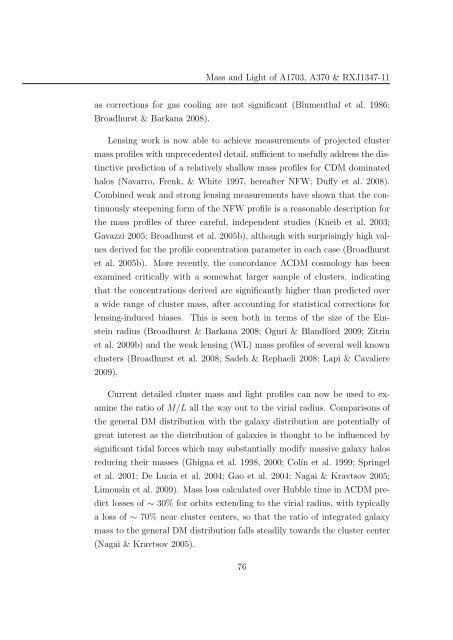Mass and Light distributions in Clusters of Galaxies - Henry A ...
Mass and Light distributions in Clusters of Galaxies - Henry A ...
Mass and Light distributions in Clusters of Galaxies - Henry A ...
You also want an ePaper? Increase the reach of your titles
YUMPU automatically turns print PDFs into web optimized ePapers that Google loves.
<strong>Mass</strong> <strong>and</strong> <strong>Light</strong> <strong>of</strong> A1703, A370 & RXJ1347-11<br />
as corrections for gas cool<strong>in</strong>g are not significant (Blumenthal et al. 1986;<br />
Broadhurst & Barkana 2008).<br />
Lens<strong>in</strong>g work is now able to achieve measurements <strong>of</strong> projected cluster<br />
mass pr<strong>of</strong>iles with unprecedented detail, sufficient to usefully address the dist<strong>in</strong>ctive<br />
prediction <strong>of</strong> a relatively shallow mass pr<strong>of</strong>iles for CDM dom<strong>in</strong>ated<br />
halos (Navarro, Frenk, & White 1997, hereafter NFW; Duffy et al. 2008).<br />
Comb<strong>in</strong>ed weak <strong>and</strong> strong lens<strong>in</strong>g measurements have shown that the cont<strong>in</strong>uously<br />
steepen<strong>in</strong>g form <strong>of</strong> the NFW pr<strong>of</strong>ile is a reasonable description for<br />
the mass pr<strong>of</strong>iles <strong>of</strong> three careful, <strong>in</strong>dependent studies (Kneib et al. 2003;<br />
Gavazzi 2005; Broadhurst et al. 2005b), although with surpris<strong>in</strong>gly high values<br />
derived for the pr<strong>of</strong>ile concentration parameter <strong>in</strong> each case (Broadhurst<br />
et al. 2005b). More recently, the concordance ΛCDM cosmology has been<br />
exam<strong>in</strong>ed critically with a somewhat larger sample <strong>of</strong> clusters, <strong>in</strong>dicat<strong>in</strong>g<br />
that the concentrations derived are significantly higher than predicted over<br />
a wide range <strong>of</strong> cluster mass, after account<strong>in</strong>g for statistical corrections for<br />
lens<strong>in</strong>g-<strong>in</strong>duced biases. This is seen both <strong>in</strong> terms <strong>of</strong> the size <strong>of</strong> the E<strong>in</strong>ste<strong>in</strong><br />
radius (Broadhurst & Barkana 2008; Oguri & Bl<strong>and</strong>ford 2009; Zitr<strong>in</strong><br />
et al. 2009b) <strong>and</strong> the weak lens<strong>in</strong>g (WL) mass pr<strong>of</strong>iles <strong>of</strong> several well known<br />
clusters (Broadhurst et al. 2008; Sadeh & Rephaeli 2008; Lapi & Cavaliere<br />
2009).<br />
Current detailed cluster mass <strong>and</strong> light pr<strong>of</strong>iles can now be used to exam<strong>in</strong>e<br />
the ratio <strong>of</strong> M/L all the way out to the virial radius. Comparisons <strong>of</strong><br />
the general DM distribution with the galaxy distribution are potentially <strong>of</strong><br />
great <strong>in</strong>terest as the distribution <strong>of</strong> galaxies is thought to be <strong>in</strong>fluenced by<br />
significant tidal forces which may substantially modify massive galaxy halos<br />
reduc<strong>in</strong>g their masses (Ghigna et al. 1998, 2000; Colín et al. 1999; Spr<strong>in</strong>gel<br />
et al. 2001; De Lucia et al. 2004; Gao et al. 2004; Nagai & Kravtsov 2005;<br />
Limous<strong>in</strong> et al. 2009). <strong>Mass</strong> loss calculated over Hubble time <strong>in</strong> ΛCDM predict<br />
losses <strong>of</strong> ∼ 30% for orbits extend<strong>in</strong>g to the virial radius, with typically<br />
a loss <strong>of</strong> ∼ 70% near cluster centers, so that the ratio <strong>of</strong> <strong>in</strong>tegrated galaxy<br />
mass to the general DM distribution falls steadily towards the cluster center<br />
(Nagai & Kravtsov 2005).<br />
76
















